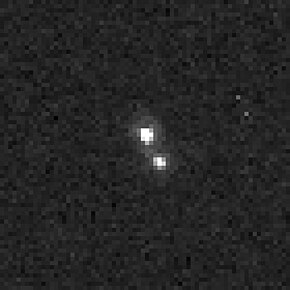 Altjira and its companion imaged by the Hubble Space Telescope in 2006 Altjira and its companion imaged by the Hubble Space Telescope in 2006 | |
| Discovery | |
|---|---|
| Discovery site | Deep Ecliptic Survey at Kitt Peak |
| Discovery date | 20 October 2001 August 2006 (secondary) |
| Designations | |
| MPC designation | (148780) Altjira |
| Pronunciation | /ælˈtʃɪrə/ |
| Alternative designations | 2001 UQ18 |
| Minor planet category | Cubewano (DES) |
| Adjectives | Altjirian |
| Orbital characteristics | |
| Epoch 13 January 2016 (JD 2457400.5) | |
| Uncertainty parameter 3 | |
| Observation arc | 2539 days (6.95 yr) |
| Aphelion | 46.877 AU (7.0127 Tm) |
| Perihelion | 41.572 AU (6.2191 Tm) |
| Semi-major axis | 44.224 AU (6.6158 Tm) |
| Eccentricity | 0.059979 |
| Orbital period (sidereal) | 294.10 yr (107421 d) |
| Mean anomaly | 124.29° |
| Mean motion | 0.0033513°/day |
| Inclination | 5.2056° |
| Longitude of ascending node | 2.0132° |
| Argument of perihelion | 297.71° |
| Known satellites | 1 |
| Physical characteristics | |
| Mean diameter | 331+51 −187 km (combined) 246+38 −139 km (primary) 221+34 −125 km (secondary) |
| Mass | 3.952×10 kg |
| Mean density | 0.30+0.50 −0.14 g/cm |
| Geometric albedo | 0.0430+0.1825 −0.0095 |
| Spectral type | B−V = 0.91±0.13 V−R = 0.74±0.08 V−I = 1.17±0.09 |
| Absolute magnitude (H) | 5.7 5.6, 5.4, or 5.1 (primary) secondary's magnitude difference with primary's: 0.7 ± 0.2 |
148780 Altjira /ælˈtʃɪrə/ is a binary classical Kuiper belt object (cubewano). The secondary, S/2007 (148780) 1, is large compared to the primary, approximately 246 kilometres (153 mi) vs. 221 kilometres (137 mi). The Altjiran lightcurve is quite flat (Δmag<0.10), which is indicative of a "quasi-spherical body with a homogeneous surface".
The satellite's orbit has the following parameters: semi-major-axis, 9904 ± 56 km; period, 139.561 ± 0.047 days; eccentricity, 0.3445 ± 0.0045; and inclination, 35.19 ± 0.19°(retrograde). The total system mass is about 4 × 10 kg.
It was named after the Arrernte creation deity, Altjira, who created the Earth during the Dreamtime and then retired to the sky.
Altjira may be an unresolved hierarchical triple system.
References
- ^ "JPL Small-Body Database Browser: 148780 Altjira (2001 UQ18)" (2008-10-02 last obs). Retrieved 26 March 2016.
- ^ Johnston's Archive on (148780) Altjira Retrieved 2011-11-29
- Marc W. Buie. "Orbit Fit and Astrometric record for 148780". SwRI (Space Science Department). Retrieved 2011-11-29.
- ^ Vilenius, E.; Kiss, C.; Mommert, M.; et al. (2014). ""TNOs are Cool": A survey of the trans-Neptunian region X. Analysis of classical Kuiper belt objects from Herschel and Spitzer observations". Astronomy & Astrophysics. 564: A35. arXiv:1403.6309. Bibcode:2014A&A...564A..35V. doi:10.1051/0004-6361/201322416. S2CID 118513049.
- ^ Grundy, W. M.; Noll, K. S.; Nimmo, F.; Roe, H. G.; Buie, M. W.; Porter, S. B.; Benecchi, S. D.; Stephens, D. C.; Levison, H. F.; Stansberry, J. A. (2011). "Five new and three improved mutual orbits of transneptunian binaries" (PDF). Icarus. 213 (2): 678. arXiv:1103.2751. Bibcode:2011Icar..213..678G. doi:10.1016/j.icarus.2011.03.012. S2CID 9571163.
- Doressoundiram, A.; Peixinho, N.; Doucet, C.; Mousis, O.; Barucci, M. A.; Petit, J. M.; Veillet, C. (2005). "The Meudon Multicolor Survey (2MS) of Centaurs and trans-neptunian objects: extended dataset and status on the correlations reported". Icarus. 174 (1): 90–104. Bibcode:2005Icar..174...90D. doi:10.1016/j.icarus.2004.09.009. S2CID 122936619.
- ^ Duffard, R.; Ortiz, J. L.; Thirouin, A.; Santos-Sanz, P.; Morales, N. (2009). "Transneptunian objects and Centaurs from light curves". Astronomy & Astrophysics. 505 (3): 1283–1295. arXiv:0910.1472. Bibcode:2009A&A...505.1283D. doi:10.1051/0004-6361/200912601.
- Nelsen, Maia A.; Ragozzine, Darin; Proudfoot, Benjamin C. N.; Giforos, William G.; Grundy, Will (2024-03-19). "Beyond Point Masses. IV. TNO Altjira is Likely a Hierarchical Triple Discovered Through Non-Keplerian Motion". arXiv:2403.12786 .
External links
| Minor planets navigator | |
|---|---|
| Small Solar System bodies | |||||||
|---|---|---|---|---|---|---|---|
| Minor planets |
| ||||||
| Comets | |||||||
| Other | |||||||
| Natural satellites of the Solar System | ||
|---|---|---|
| Planetary satellites of |   | |
| Dwarf planet satellites of | ||
| Minor-planet moons | ||
| Ranked by size | ||